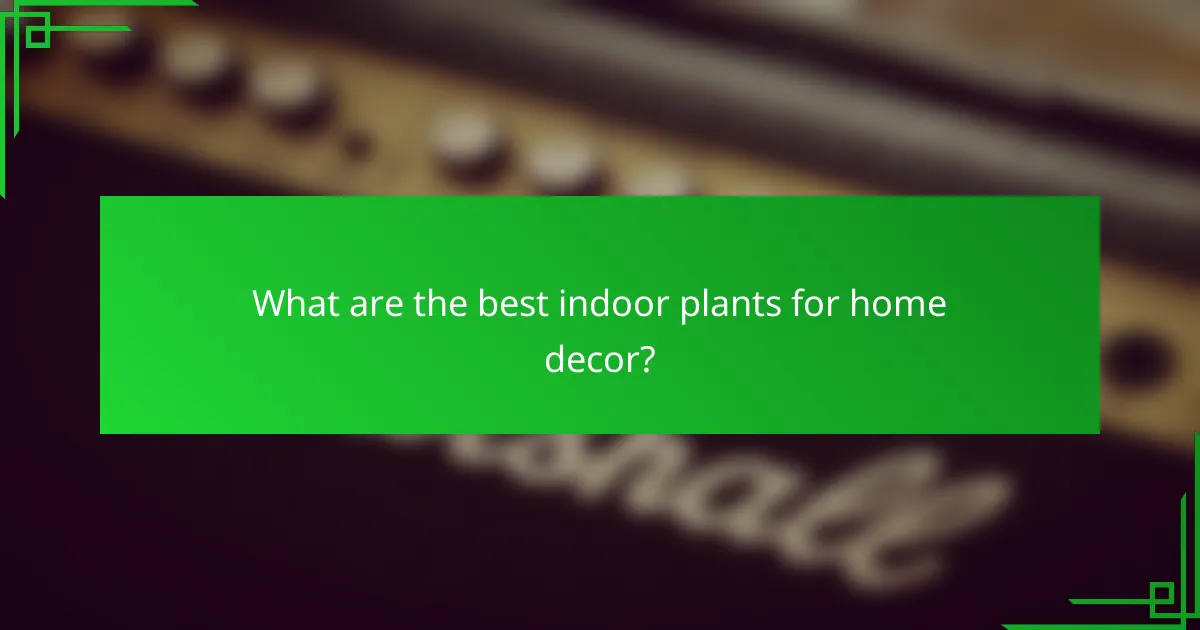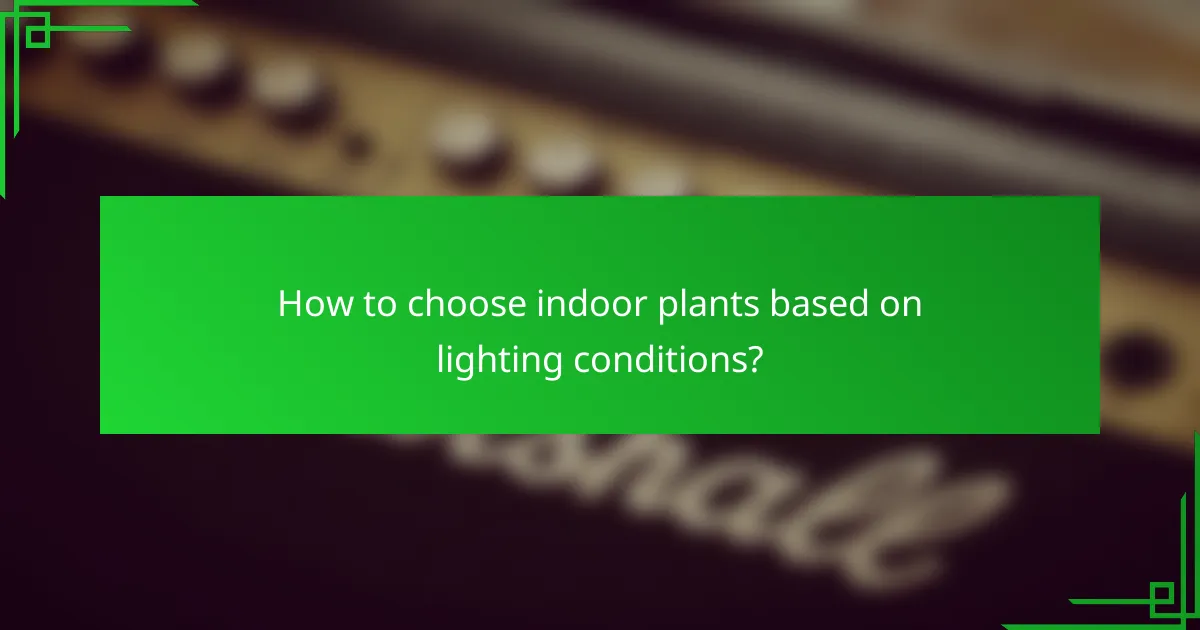Indoor plants are a fantastic way to elevate your home decor while simultaneously enhancing air quality. By choosing visually appealing and low-maintenance options, you can create a vibrant atmosphere that complements your interior design and promotes a healthier living environment.

What are the best indoor plants for home decor?
The best indoor plants for home decor enhance your living space while improving air quality. Popular choices include those that are visually appealing, easy to care for, and adaptable to various lighting conditions.
Fiddle Leaf Fig
The Fiddle Leaf Fig is known for its large, glossy leaves that can make a bold statement in any room. This plant thrives in bright, indirect light and prefers a warm environment, making it ideal for living rooms or sunrooms.
When caring for a Fiddle Leaf Fig, ensure it has well-draining soil and avoid overwatering, as this can lead to root rot. Regularly dust the leaves to keep them clean and allow for optimal photosynthesis.
Snake Plant
The Snake Plant, or Sansevieria, is a resilient choice that can tolerate low light and infrequent watering. Its upright, sword-like leaves add a modern touch to any decor style.
This plant is particularly beneficial for improving indoor air quality, as it converts CO2 into oxygen at night. Place it in a pot with drainage holes to prevent water accumulation and promote healthy growth.
Pothos
Pothos is a versatile trailing plant that can thrive in various lighting conditions, making it perfect for shelves or hanging baskets. Its heart-shaped leaves come in a variety of colors, adding visual interest to your space.
To care for Pothos, water it when the top inch of soil feels dry. This low-maintenance plant is forgiving, making it a great option for beginners. Prune regularly to encourage bushier growth and remove any yellowing leaves.
Peace Lily
The Peace Lily is celebrated for its elegant white blooms and ability to thrive in low light. This plant not only beautifies your home but also helps purify the air by removing toxins.
Keep the soil consistently moist but not soggy, and mist the leaves occasionally to maintain humidity. Be cautious, as the leaves can droop when the plant needs water, making it easy to gauge its needs.
Rubber Plant
The Rubber Plant features large, dark green leaves that can add a touch of sophistication to your decor. It prefers bright, indirect light but can adapt to lower light conditions, making it a flexible choice for various spaces.
Water the Rubber Plant when the top inch of soil is dry, and ensure it has good drainage. Regularly wipe the leaves to keep them dust-free and allow the plant to thrive. This plant can grow quite tall, making it an excellent focal point in larger rooms.

How do indoor plants enhance interior design?
Indoor plants significantly enhance interior design by adding natural beauty and improving the overall ambiance of a space. They not only serve as decorative elements but also contribute to a healthier indoor environment.
Improves air quality
Indoor plants can enhance air quality by filtering harmful pollutants and releasing oxygen. Common houseplants like peace lilies, spider plants, and snake plants are known for their air-purifying abilities, making them excellent choices for improving indoor air.
To maximize air quality benefits, consider placing multiple plants in various rooms. A general guideline is to have at least one plant per 100 square feet of living space for optimal air purification.
Adds color and texture
Indoor plants add vibrant colors and varied textures to interior spaces, creating visual interest and depth. From the lush green of ferns to the striking hues of flowering plants, they can complement any decor style.
When selecting plants, think about the color palette of your room. For a cohesive look, choose plants that either match or contrast with existing colors. Using different leaf shapes and sizes can also enhance the textural diversity in your decor.
Creates a calming atmosphere
Incorporating indoor plants can create a calming atmosphere, promoting relaxation and reducing stress. Studies suggest that being around greenery can lower anxiety levels and improve mood.
To foster a serene environment, consider placing plants in areas where you spend time unwinding, such as living rooms or bedrooms. Soft, low-maintenance plants like succulents or bamboo can be particularly effective in enhancing tranquility without requiring extensive care.

What are the top indoor plants for small spaces?
For small spaces, the best indoor plants are those that require minimal care and can thrive in limited light. Options like the Spider Plant, ZZ Plant, and Dracaena are excellent choices due to their adaptability and aesthetic appeal.
Spider Plant
The Spider Plant is a popular choice for small spaces due to its ability to tolerate various light conditions and its air-purifying qualities. It typically grows to about 30 cm in height and produces long, arching leaves that can create a lush look without taking up much room.
To care for a Spider Plant, ensure it receives indirect sunlight and water it when the top inch of soil feels dry. Avoid overwatering, as this can lead to root rot. Regularly removing any brown tips on the leaves will keep the plant looking its best.
ZZ Plant
The ZZ Plant is known for its resilience and low maintenance requirements, making it ideal for small spaces. It can thrive in low light and only needs watering every few weeks, which is perfect for busy individuals or those new to plant care.
When placing a ZZ Plant, choose a spot with indirect light to prevent leaf burn. Its glossy leaves add a touch of elegance to any decor, and it can grow up to 1 meter tall, providing a striking visual element without overwhelming the space.
Dracaena
Dracaena plants are versatile and come in various species, making them suitable for different decor styles. They can grow between 1 to 2 meters tall, depending on the variety, and their striking foliage can enhance the aesthetics of small rooms.
These plants prefer moderate light and should be watered when the top inch of soil is dry. Be cautious of overwatering, as Dracaena is sensitive to excess moisture. Regularly dusting the leaves will help maintain their vibrant appearance and improve photosynthesis.

How to choose indoor plants based on lighting conditions?
Choosing indoor plants based on lighting conditions is crucial for their health and growth. Different plants thrive in varying light environments, so understanding these requirements helps ensure your decor remains vibrant and lush.
Low-light plants
Low-light plants are ideal for spaces that receive minimal natural light, such as offices or rooms with small windows. Common options include the snake plant, pothos, and ZZ plant, which can survive in shaded areas and require less frequent watering.
When selecting low-light plants, consider their growth rate and size. Some may grow slowly, while others can expand significantly over time. Ensure you have enough space for their potential growth to avoid overcrowding.
Bright indirect light plants
Bright indirect light plants flourish in areas that receive plenty of filtered sunlight, such as near sheer curtains or in well-lit rooms. Popular choices include peace lilies, spider plants, and philodendrons, which appreciate bright conditions without direct sun exposure.
To maintain these plants, rotate them occasionally to ensure even growth and monitor their watering needs, as they may require more moisture compared to low-light varieties. Avoid placing them in direct sunlight, as this can scorch their leaves.
Direct sunlight plants
Direct sunlight plants thrive in spaces that receive full sun for several hours a day. Succulents, cacti, and some herbs like basil and rosemary are excellent choices for these bright environments. They typically require well-draining soil and less frequent watering.
When placing direct sunlight plants, ensure they are positioned where they can absorb sunlight without obstruction. Keep an eye on their water needs, as they can dry out quickly in bright conditions. Regularly check for pests, as sunny spots can attract unwanted insects.

What are the best indoor plants for pet owners?
Pet owners should consider non-toxic indoor plants that are safe for their furry friends. Some of the best options include plants that not only enhance decor but also pose minimal risk to pets if ingested.
Boston Fern
The Boston Fern is an excellent choice for pet owners due to its non-toxic nature. This lush, feathery plant thrives in humid environments and can add a vibrant touch to any room.
When caring for a Boston Fern, ensure it receives indirect sunlight and keep the soil consistently moist. This plant prefers higher humidity levels, so consider placing it in a bathroom or kitchen where moisture is abundant.
Common pitfalls include allowing the soil to dry out or exposing the fern to direct sunlight, which can cause browning of the fronds. Regular misting can help maintain humidity and keep the plant healthy.
